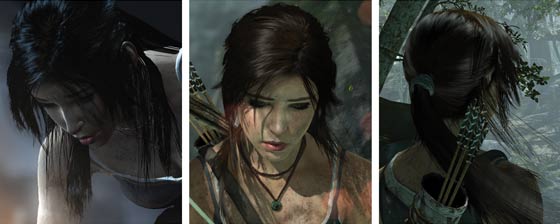AMD has revealed a new real-time hair rendering technology called AMD TressFX. The new “revolutionary” method, which aims to bring realistic hair to computer games, was developed in collaboration with Crystal Dynamics using the DirectCompute programming language.
AMD says that, until now, realistic hair has been out of reach of games designers to implement as it’s one of the “most complex and challenging materials to accurately reproduce in real-time.” A new blog post on the AMD Game Blog says that games characters have historically tended to be very fond of wearing helmets or seem to overindulge in hairspray. This is because “Convincingly recreating a head of lively hair involves drawing tens of thousands of tiny and individual semi-transparent strands, each of which casts complex shadows and requires anti-aliasing. Even more challengingly, these calculations must be updated dozens of times per second to synchronize with the motion of a character”.

Tomb Raider
AMD worked with Crystal Dynamics using the DirectCompute programming language and the “massively-parallel processing capabilities of the Graphics Core Next architecture” to create luscious locks for the main character of Lara Croft. The 2013 version of Tomb Raiser uses AMD TressFX to render Lara’s hair in the game of a quality “previously restricted to pre-rendered images”.

TressFX hair is affected by gravity, wind and movement and has been designed to react in a realistic fashion. We are told that Lara’s pony tail reacts more realistically than ever as she leaps and bounds around the in game scenery. AMD has also implemented realistic wet and dry hair – it reacts to the effects of moisture in the game environments. Have a look through the pictures and see what you think.

What if you have an NVIDIA graphics card?
If you want to have a good hair day the AMD Game Blog suggests “Graphics cards featuring the Graphics Core Next architecture, like select AMD Radeon HD 7000 Series, are particularly well-equipped to handle these types of tasks, with their combination of fast on-chip shared memory and massive processing throughput on the order of trillions of operations per second”. However, what if you have NVIDIA hardware? Bit-Tech contacted AMD about this very question and a spokesperson replied “TressFX is not exclusive to AMD, it works on any DirectX11 card, similar to some other AMD-built technologies - for example Order-Independent Transparency (OIT) or High Definition Ambient Occlusion (HDAO).” So it looks like if you have a decent NVIDIA card you can also enjoy TressFX hair in games.
Overall the stills look great but it’s a pity there isn’t a video to show off the realism mentioned in the blurb.
AMD to sell a version of the PS4 APU to PC builders
In further AMD news it has been revealed that the company will be making available a version of the chip powering the Sony PlayStation 4 to ordinary folk and PC builders. The chip will be the same AMD Jaguar APU minus some Sony technology and custom specifications.
John Taylor, head of marketing for AMD's Global Business Units, told The Inquirer that the APU will be available to consumers later this year. The chip made available to consumers will be the based on the same technology but sounds like it will be cut down in several ways. Talking about Sony’s PS4 reveal AMD’s Taylor said “Everything that Sony has shared in that single chip is AMD [intellectual property], but we have not built an APU quite like that for anyone else in the market. It is by far the most powerful APU we have built to date, it leverages [intellectual property] that you will find in our A-series APUs later this year, our new generation of APUs but none that will quite be to that level of sheer number of cores, sheer number of teraflops.”
When AMD launches its third generation of APUs later in the year and the Sony PS4 is available it will be interesting to compare what differences and enhancements the Sony technology and chip specification makes to games titles across systems. However I’m sure both systems will offer nice in-game hair.













